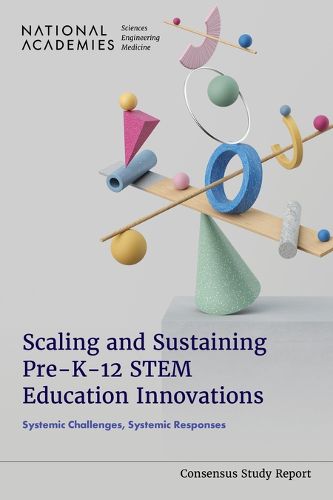Readings Newsletter
Become a Readings Member to make your shopping experience even easier.
Sign in or sign up for free!
You’re not far away from qualifying for FREE standard shipping within Australia
You’ve qualified for FREE standard shipping within Australia
The cart is loading…






In the modern history of the United States, investment in the teaching of science, technology, engineering and mathematics has resulted in a rich variety of education innovations (programs, practices, models, and technologies). Although a number of these innovations have had the potential to impact learners on a broad scale, that potential often remains unrealized. Efforts vary in their success in widescale implementation and sustainability across different educational contexts - leaving questions about how to achieve the major improvements to STEM education that many policy leaders seek.
Scaling and Sustaining Pre-K-12 STEM Education Innovations: Systemic Challenges, Systemic Responses examines the interconnected factors at local, regional, and national levels that foster or hinder the widespread implementation of promising, evidence-based Pre-K-12 STEM education innovations, to identify gaps in the research, and to provide guidance on how to address barriers to implementation. This report comes in response to a mandate within the CHIPS and Science Act of 2022.
Table of Contents
Front Matter Summary 1 Introduction 2 Landscape of STEM Education Learning Opportunities: Federal, State, Local, and Regional Roles 3 History of Federal and National STEM Education Improvement Efforts 4 Approaches to Scaling and Sustaining Innovations 5 Navigating the Landscape of STEM Innovation and Implementation 6 Technology in STEM Education 7 Promising Pre-K12 STEM Education Innovations 8 Enabling and Constraining Factors and the Need for System Change 9 Conclusions, Recommendations, and Research Agenda Appendix A: Biosketches Appendix B: Development of the Compendium Appendix C: Compendium
$9.00 standard shipping within Australia
FREE standard shipping within Australia for orders over $100.00
Express & International shipping calculated at checkout
In the modern history of the United States, investment in the teaching of science, technology, engineering and mathematics has resulted in a rich variety of education innovations (programs, practices, models, and technologies). Although a number of these innovations have had the potential to impact learners on a broad scale, that potential often remains unrealized. Efforts vary in their success in widescale implementation and sustainability across different educational contexts - leaving questions about how to achieve the major improvements to STEM education that many policy leaders seek.
Scaling and Sustaining Pre-K-12 STEM Education Innovations: Systemic Challenges, Systemic Responses examines the interconnected factors at local, regional, and national levels that foster or hinder the widespread implementation of promising, evidence-based Pre-K-12 STEM education innovations, to identify gaps in the research, and to provide guidance on how to address barriers to implementation. This report comes in response to a mandate within the CHIPS and Science Act of 2022.
Table of Contents
Front Matter Summary 1 Introduction 2 Landscape of STEM Education Learning Opportunities: Federal, State, Local, and Regional Roles 3 History of Federal and National STEM Education Improvement Efforts 4 Approaches to Scaling and Sustaining Innovations 5 Navigating the Landscape of STEM Innovation and Implementation 6 Technology in STEM Education 7 Promising Pre-K12 STEM Education Innovations 8 Enabling and Constraining Factors and the Need for System Change 9 Conclusions, Recommendations, and Research Agenda Appendix A: Biosketches Appendix B: Development of the Compendium Appendix C: Compendium